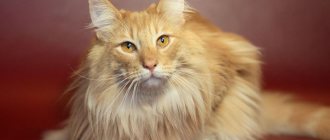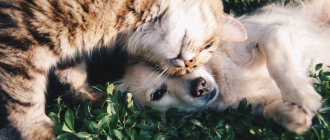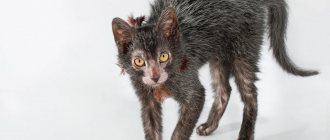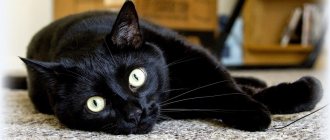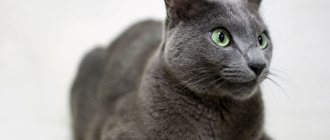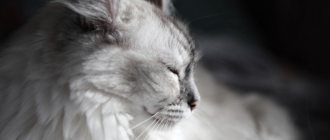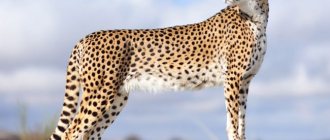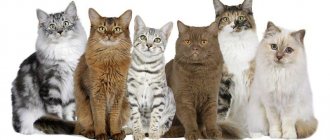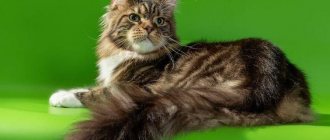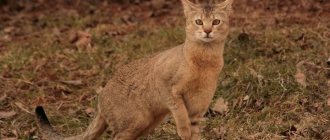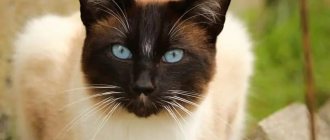Among the variety of cat breeds, there are both very large and small, and even very tiny in size. Thus, the most impressive are the representatives of the Savannah breed, which can reach up to 15 kg in weight and grow up to 60 cm in height. But which cats can be considered the smallest? Small breeds of cats are those whose representatives do not exceed 3.1 kg in weight, and there are quite a lot of them.
Even though the difference in size and weight between cat breeds is not as noticeable as between dogs, it is still worth studying this aspect. So which cats can be considered the smallest?
Singapore cats
This is the smallest breed of domestic cat. Singapore cats usually grow up to 16 cm in height, the smallest can be only 11 cm tall. Despite their miniature size, these pets are famous for their energy and playful nature.
The true history of the breed remains a mystery. The generally accepted version is that two American breeders, Helu and Tommy Meadow, found three kittens of this breed on the streets of Singapore and brought them to the United States, where they continued to breed them. Some experts later suggested that the breed may not actually have a natural origin. Their miniature size, small litter and other factors indicate that Singapura cats were specially bred by someone. There are suggestions that this is a cross between Burmese and Abyssinian cats. The average litter of a Singapura cat consists of only 2-3 kittens, which is partly the reason for the rarity of this breed. A kitten from a breeder can cost $800-2000, depending on the pedigree.
Singapura cats take up to two years to reach their full size, but even adult cats end up weighing only 1.8-3.6 kg. However, size is not their only defining feature. These playful felines have the energy of several big cats combined. Singapura cats are also distinguished by large ears and huge, round, saucer-shaped eyes that can be brown, green or yellow.
The coat comes in only one color - sepia agouti. This is basically a fancy name for a ticked/striped pattern with dark brown spots on light cream fur. These cats have short, silky hair that is lighter in color near the chest, belly, and face. The tail has a dark end. Although Singapura cats do not shed excessively, they are not hypoallergenic. There is quite a lot of dandruff on their skin, which irritates the mucous membranes of allergy sufferers.
These exotic cats attract extroverts who love to be the center of attention. They are energetic, assertive and playful, but do not tolerate loud noises and loneliness well. Singapura cats value affection above all else. They often insist on attention to the point where it's a little annoying. Singapura cats love to meow, often for no reason. Luckily, their soft voices make the constant meowing relatively enjoyable. Although these inquisitive pets can sometimes seem bossy and demanding, they will always remain loving four-legged companions.
Singapura cats love to jump on high places, climb on cabinets and even sit on the shoulders of their owners. This interactive, intelligent cat breed is easy to train. They are friendly towards people and other pets. However, due to their tiny size, Singapura cats can be a bit timid. Early introduction to your pets is the best way to socialize this breed. The lifespan of Singapura cats is 9-15 years.
In fifth place is a breed called Dwelf.
To create this breed, breeders worked hard and crossed the Munchkin, the Canadian Sphynx and the American Curl. As a result of mating, the result was a rather cute hairless kitten with short legs. Keeping a cat of this breed is not difficult, but you need to remember that by inheritance from three different breeds, the Dwelf has a stubborn character. Therefore, a cat must be raised correctly from an early age. Adults of this breed weigh from 1.8 to 3 kg.
Munchkin
Named after the fairy folk from The Wizard of Oz, the Munchkin is perhaps one of the most famous small cat breeds. They have tiny bow legs that give them a charming gait. The average height of a Manchin is 16 cm. The shortest representative of the breed had a height from paw to shoulder of only 13.5 cm! In other respects, this miniature breed corresponds to the size of an ordinary adult cat.
This is a relatively new breed, officially recognized at the beginning of the 21st century. The munchkin mutation does not depend on gender; the mutating gene is dominant. The main thing when mating is that one of the pair should not have a mutation. If two munchkins are mated, the mutation is fatal. Due to the difficulty of breeding, munchkins are relatively rare.
Visually, these cats resemble a dachshund. They are sometimes called "sausage cat". Munchkins come in long-haired, short-haired and hairless varieties. The former have smooth, silky fur, while the latter have soft, medium-density fur. Popular fur shades are grey, cream and solid white/black.
Munchkins are friendly and sociable by nature. This calm breed of cat quickly develops bonds with other pets, small children and the elderly. Munchkins love to explore the world around them. While they can't jump as high or far as the average cat, they are very fast and active, so be prepared to have an ever-playful kitty in your home. Munchkins are a healthy cat breed with a life expectancy of 12-15 years.
Bambino
In the early 2000s, the Osborne couple from Arkansas, USA, acquired a funny cat. It was a sphinx, but with very short legs, and it looked rather miniature. The couple liked their new pet so much that they decided to breed and sell such animals.
Bambino is the result of crossing a munchkin and a sphinx, its weight is between 2-4 kg. Pat Osborne is the author of the title. Translated from Italian, this word means “child”. The breed was registered in 2005, and then it first appeared in Russia.
The official organization TICA does not recognize the bambino as an independent breed, while it is cautiously called experimental. In some countries, such crossbreeding is prohibited as cruelty to animals.
Cornish Rex
Due to their unique appearance, Cornish Rex cats are ideal for people with avant-garde taste. They were first launched on July 21, 1950. As the kitten (later named Callibunker) grew up, he became strikingly different from his littermates with a slender body, long thin legs, huge bat ears and a tousled tail. The veterinarian identified Kallibunker as a completely unique genetic mutation.
The bodies of Cornish Rex dogs are extremely thin, giving them the appearance of fragile animals. This is just a ploy, as their hard muscles and bones make them surprisingly tough cats that often weigh much more than they appear. Their weight can reach 4.5 kg. Cornish Rex dogs are sometimes compared to hounds or greyhounds due to their athletic build and quick movements. This breed also has a tendency to arch its back when walking.
The main distinguishing feature of the Cornish Rex is their coat. They only have an undercoat, somewhat reminiscent of soft sheep's wool. One of the disadvantages of such a soft, short coat is that cats do not tolerate cold conditions well, and they also do not have sufficient protection from direct sunlight, which can lead to sunburn if they stay outside for long periods of time. So these babies are definitely homemade.
The Cornish Rex is an incredibly curious, bright, energetic breed. These are natural climbers and jumpers. They are also voracious eaters. But since the breed is active enough to burn calories quickly, gaining weight is not a problem. The Cornish Rex is an extremely social breed, sometimes called the "Velcro cat."
Cornish Rex cats are very tough. They are long-lived (15 years is the norm, but 20 years is not uncommon), the breed has virtually no hereditary or genetic health problems. The only problem this breed is prone to is hair loss, which, while not life-threatening, can be severe enough that some cats have almost no fur at all.
Lembkin
Lembkin translates to "lamb" in English and is the word that best describes this breed. Miniature cats with curly hair, like a sheep's, will not leave anyone indifferent.
In addition to their fur, lambkins are distinguished by short legs, like munchkins. They weigh no more than 3-4 kg, and their color is not strictly defined. This breed cannot be called established; not all kittens from the litter still inherit the desired characteristics, and scientists continue to work on selection.
American Curl
The American Curl comes in a wide range of sizes due to its diverse gene pool, however most tend to be quite petite. Their most famous feature is the curled ears towards the base of the skull, which give the breed its name. The unusual bend gives the ears the appearance of ears turned inside out. For show cats, ears are the most stringent criterion. Representatives of the breed whose ears are curled too far (more than 180 degrees) or insufficiently (less than 90 degrees) will be disqualified.
The American Curl was first bred in 1981 in Lakewood, California. A black long-haired cat named Shulamith became the progenitor of a new breed, from which every American Curl today can trace their ancestry. The curvature of her ears was a spontaneous, natural mutation that manifested itself as a dominant gene. More in-depth laboratory testing showed that the mutation did not lead to additional defects or health problems. Shulamith's offspring were absolutely healthy and stable cats.
At birth, their ears are erect; they begin to curl after 2-10 days. The ears curl and unfold to varying degrees over the next four months. When the ears take their final shape, the lower two-thirds of the ear is hard cartilage rather than soft flesh like most cat breeds. The upper third remains soft and pliable. You need to be careful with the ears of the American Curl so as not to damage the hard cartilage. But in other respects they are a fairly unpretentious breed.
The American Curl has a wedge-shaped muzzle, an elongated body and round eyes. The height of cats varies from 22 to 30 cm. The curly coat is long or short. They are friendly, captivating and incredibly cute pets. The American Curl, which remains energetic into adulthood, has been nicknamed “the cat’s Peter Pan.” Cats reach maturity at 2-3 years, so they retain the energy of a kitten into adulthood.
This is not a very vocal cat breed and in most cases they express affection through physical contact. The American Curl is an extremely adaptable cat, getting along well with other cats and quickly adapting to new family members. If necessary, they will do well alone for long periods of time.
Where can I buy a Kinkaloo kitten?
Since the breed was bred and recognized relatively recently, there are not many nurseries with it. In Russia, only one nursery is registered with the felinological association TICA and delivers directly from America.
The price tag for a small Kinkaloo kitten starts from 35 thousand rubles. The price level varies depending on the breed, characteristics and appearance. For example, cats with curled ears but longer legs will cost several tens of thousands less than standard Kinkalow breeds.
What you should pay attention to when choosing a pet:
- first of all, it is a physical condition;
- external characteristics: thickness, softness and shine of the coat. The length of the paws and the degree of curvature of the ears;
- You should choose a kitten three weeks after birth. It is at this time that the ears begin to curl.
Experienced breeders provided statistics on the birth of kinkalows from American curls and munchkins. Only 30% of kittens are born with mutations, i.e. short legs and folded ears. In most cases, standard munchkin or curl breeds are born. Therefore, the cost of this breed is very high.
Devon Rex
Devon Rex cats are nicknamed "poodle cats" due to their wavy coat, high intelligence, and outgoing nature. This unique breed originated in the 1950s in Devon, England. They are distinguished by mischievous faces, high ears, huge eyes and a slender physique. The Devon Rex loves to play and climb, so it is perfect for active owners who can devote a lot of time and attention to their pet. These super social cats love people and love making new friends. They crave attention and do not tolerate loneliness well.
The Devon Rex has an elfin, almost alien appearance. This is a medium-sized cat, weighing 2.7-4.1 kg and standing about 25.4-30.5 cm in height. These curly cuties have fine, thick and wavy fur. Their fur is short, but it is especially short and less dense around the head, ears, neck, paws, chest and belly. This breed is not hypoallergenic.
Cuddling and fooling around with their owners is the Devon Rex's favorite pastime. He is not aggressive and prefers to walk away rather than deal with rude people. These cats remain playful into old age, maintaining the energy of a kitten well into old age. Although the Devon Rex can be a little demanding, it is not a particularly noisy cat breed.
They are highly intelligent, easy to train, play maze games and can learn complex tricks. However, these stubborn cats are difficult to motivate. Praise, games, and snacks are good tools.
Caring for a Devon Rex is quite simple. But it is worth considering that his short coat can easily become oily, so your pet needs to be regularly bathed in warm water with a mild pet shampoo.
Necessary living conditions
Kinkalows easily adapt to any living conditions and tolerate moving and long journeys well. This breed should not be left alone for a long time: pets need the company and attention of their owners, and therefore, if there is no one in the apartment for a long time, they will soon begin to get bored and sad. In this regard, the Kinkaloo differs from other breeds in its lack of independence. These cats love to play together in coziness and comfort and will appreciate the beds and houses you buy. To make caring for your kinkalow easier, you should also purchase a tray and a scratching post. For short-legged pets, structures with low sides are suitable so that they can easily climb up there.
Kinkaloo is a good-natured and cheerful animal, always ready to support a new idea or game.
The Kinkaloo breed is noted for its curiosity and love for small objects. In order not to lose various small items from the bottom drawers of chests of drawers and tables, it is recommended to put these items higher where the pet cannot climb.
Japanese Bobtail
This breed makes excellent pets. Japanese Bobtails are valued for their short curved tails, playful nature and hyperactivity. This adorable breed originates from Japan but is famous all over the world. The Japanese Bobtail is an ancient breed, bred back in the 6th century. These cats were often used to control rodents on farms. Although the Japanese Bobtail was once considered a luxurious pet, inaccessible to ordinary people. These cute, quirky cats are relatively rare outside of their homeland.
The defining physical characteristic of the Japanese Bobtail is, of course, the “clipped” cat tail. It looks more like a rabbit than a cat. The tail of the Japanese Bobtail is usually no longer than 7 cm, covered with tufts of fur and curled or curled to one side. Just like fingerprints, no two tails of this breed are alike.
The Japanese Bobtail is a short breed, growing to a maximum of 23 cm. Cats weigh 2.7-4.5 kg. They have long and muscular bodies, high cheekbones and oval eyes. Their forelimbs are slightly shorter than their hind limbs. Japanese Bobtails have two types of coat: long and short. The coloration can be solid, two-tone or striped, but the most common are white cats with colored spots. The coat is silky smooth, easy to care for and low shedding. They have no undercoat, so their hair is not prone to tangling. It is recommended to brush the coat once a week to remove dead hairs.
Japanese Bobtails are stubborn and courageous and are not easily intimidated. These energetic animals are especially loyal with children, dogs and other cats, especially other bobtails. They remain active for most of their lives. Japanese Bobtails are sociable, friendly and very intelligent. These cats love to be the center of attention, often attracting attention with their gentle melodious voices. They almost always respond when spoken to.
The lively Japanese Bobtail loves activity and does not need external motivation to exercise. They love to snack, but their active lifestyle does not always prevent obesity, so you need to monitor your bobtail's treats and food intake to prevent it from gaining excess weight. This breed is considered healthy and disease resistant. The lifespan of Japanese Bobtails is 9-15 years.
Choice of kitten and price
Buying a kitten outside the States will be very problematic. Very few breeders in the rest of the world practice the breed as it is currently experimental. Although there are amateurs both in Russia and in neighboring countries. Some breed kinkalows on their own and have breeding stock, others engage in resale and delivery of kittens from Europe and America. As a rule, there is a long queue for kittens from small litters.
Future owners should take into account that in one Kinkalow litter several types of kittens are born: standard (with short legs and curled ears) and the so-called non-standard (kittens can have only curled ears or only short legs, or regular ears and long legs). Naturally, the price for them differs significantly.
Price
Standard kinkalows cost at least $1,000, while non-standard ones start from $250. The only proof that kittens belong to the breed is the pedigree.
Siamese cats
These are sociable, affectionate, intelligent animals that make the most devoted pets. Siamese cats are considered one of the oldest existing Asian cat breeds. They originated in Thailand (formerly Siam) and were highly prized by the royal family. They were imported to Europe at the end of the 19th century. Since then, the popularity of Siamese cats has only continued to grow, and they are consistently considered one of the most popular cat breeds in the world. They were used to create other cat breeds, including the Himalayan, Burmese and Tonkinese.
Siamese cats are known for their "dog-likeness." They have a lean body with long, thin limbs and a tail, which when combined with the high-contrast colorpoint pattern makes them instantly recognizable. The fur of Siamese cats is darkened on the face, ears, paws and tail. This breed has piercing blue eyes (which can sometimes be a little cross-eyed), which adds to the elegance of Siamese cats. They do not shed much, so they are good for people with allergies.
Siamese cats are friendly, affectionate, sociable and emotionally sensitive. This beautiful breed is also one of the smartest in the world. You need to shower them with love so that they don't feel abandoned. Siamese cats are howlers, although some are not so talkative. While cats do well in homes where people spend a lot of time, being away from human interaction for long periods of time can lead to depression and anxiety.
Siamese cats need to be fed high-quality food and their food intake must be monitored to prevent obesity, which they are prone to. Siamese cats are extremely healthy and have an impressive lifespan of 15-20 years, with some even living longer than that.
Skookum
Another cat with curly hair in our top is Skookum . Translated from the Indian language, its name means “strong, unbending.” This is a small cat weighing from 2 to 4 kg, covered with thick curly hair, especially on the collar. It was obtained by crossing a Munchkin and a Laperm.
In 2006, the breed was recognized as experimental, and its representatives remain rare and expensive animals. You can purchase Skookum from breeders in the USA or Europe.
These cats seem incredibly cute, and in fact they are. Affectionate, loving and cheerful pets.
How to choose a dwarf kitten
Short-legged cats are very rare in Russia.
And if you want to get a high-breed animal with rare blood for our latitudes, then it will have to be delivered from afar, most likely from overseas. Healthy kittens usually tolerate such long transport well, and there should be no problems here. Problems may arise when you receive a live “package” and suddenly find out that its contents do not correspond to what you dreamed of. This, unfortunately, happens quite often. Is it possible to minimize risks?
This blue dream may well settle in your home
Better closer than farther
Of course, the task is simplified if the future owner has the opportunity to personally go for his favorite baby. On site, in the nursery, you can get a lot of useful information:
- meet the breeder directly;
- find out the real conditions of keeping and condition of animals in the nursery;
- see the baby’s littermates and parents, their tests and other documents;
- observe the behavior of the kitten in its usual conditions;
- “live” to conclude a contract and discuss the nuances of caring for your pet.
If possible, look at the parents of your future pet
If you have the opportunity to choose between a kitten from distant countries and a domestically bred baby, perhaps it would make sense to lean in favor of the second option? “Tit in hand” is more reliable in many respects, especially since recently large Russian breeders have begun breeding popular mini-breeds:
- munchkin;
- Singapore;
- Napoleon;
- bambino and some others.
You can choose a skif-tay-don kitten personally, and not by correspondence
Decide on your desires and capabilities
Of course, the problem of choosing a pet is not at all limited to the “near-far” framework - this is a very serious question, and you need to treat it with full responsibility:
- Do not buy a kitten spontaneously - just because, for example, your friends have the same one.
- Discuss the breed and gender of your pet in advance with your family - you will not have a toy, but a new family member.
- Decide whether you need a show animal or a pet - the price of the kitten greatly depends on this.
- Get as much information as possible about the characteristics of the breed you have chosen - there should be no unpleasant surprises.
- Consult with experts which nursery is better and more reliable to make a purchase from.
- Do not rush to take the baby away from his mother too early - by four months he will be fully vaccinated and strong enough to move to a new place.
And be sure to take care of the dowry for your pet in advance - everything should be ready for his arrival at your home. And you will need a lot, because even dwarf cats grow very quickly, their interests and needs can change dramatically in just a few months.
Snow shu
White “socks” on the paws add tenderness and cuteness to the animal. A unique breed that combines the features of two types of cats: Siamese and American Shorthair.
She has a balanced character, is extremely intelligent and is easy to learn. Snowshoe can open any door in the house. The love for the owner is strong, but unobtrusive.
Thanks to her sociability, the fluffy beauty quickly gets to know anyone who enters the house. It protects its owner, licks its face and hands and knows how to warn of danger. Snowshoes have a great love for children, and they are ready to participate in games both at night and during the day.
Toy bob
The full name of the breed is Scythian-toy-bob , and its representatives look like miniature cats with a short tail and a color similar to Siamese cats. Today, some federations allow other colors, but this is how the breed was originally conceived, bred and described.
This is the smallest cat in the world, its weight ranges from 1.5-2 kg, while official descriptions indicate that the weight should not exceed 2 kg. According to breeders, toy beans are very affectionate and devoted animals, they are good companions and loyal to humans.
1 0
